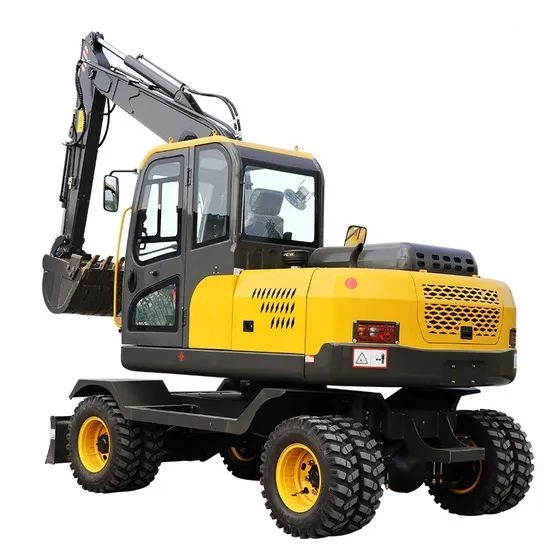When the tonnage is the same, the "cost-effectiveness" of crawler excavators and wheeled excavators needs to be judged based on specific usage scenarios, and the advantages and limitations of the two are significantly different. The following is a detailed comparison from the dimensions of core performance, applicable scenarios, and costs to help you choose according to your needs:

I. Comparison of Core Performance
| Performance Dimension | Crawler Excavator | Wheeled Excavator |
|---|---|---|
| Ground Adaptability | Extremely strong. The crawler has a large ground contact area (low pressure), allowing operation on muddy, soft ground (such as farmland, construction sites), steep slopes (≤30°), and even slight wading. | Relatively weak. It relies on hard roads (highways, hardened sites). It is prone to getting stuck on muddy or soft ground and has poor stability on steeper slopes. |
| Operational Stability | The crawler has a large support area and the machine body has a low center of gravity. It is not easy to shake during heavy-duty operations (such as crushing, heavy-duty excavation) and has higher precision. | The tire support area is small and the center of gravity is higher. Stability is poor under heavy loads or complex working conditions, and it is easy to slip or tip over. |
| Mobility Flexibility | Slow short-distance movement speed (≤5km/h). Long-distance transportation requires a trailer, resulting in high transfer costs and low efficiency. | Can drive directly on roads (some models meet highway standards with a speed of ≥20km/h). It has high efficiency in short-distance transfers (such as between multiple construction sites) and no additional transportation costs. |
| Operation Range | The crawler can rotate 360°, and combined with the boom and bucket, it has a larger excavation radius and depth, suitable for operations in complex terrain. | The tire steering angle is limited, and the excavation range is restricted by the flexibility of the machine body, making it more suitable for flat and open sites. |
| Power and Fuel Consumption | The engine power is usually higher, suitable for high-intensity operations, but fuel consumption is higher (due to large crawler driving resistance). | The power is slightly lower, and fuel consumption is lower (due to small tire rolling resistance), suitable for medium and low-intensity operations. |
II. Applicable Scenarios: The Key to Determining Cost-Effectiveness
1. Scenarios where crawler excavators are more cost-effective
- Field/complex terrain operations: Such as mining, farmland transformation, river dredging, infrastructure construction sites (unhardened ground), etc. The ground adaptability and stability of crawlers are core needs, and wheeled excavators are almost irreplaceable.
- High-intensity/heavy-duty operations: Such as crushing hard rocks, heavy-duty excavation (such as construction waste, projects with a large amount of earthwork). The power and stability of crawler excavators can ensure efficiency and reduce failures.
- Long-term fixed-site operations: Such as large construction sites (construction period ≥3 months). There is no need for frequent transfers, and the high operational efficiency of crawler excavators can cover their transfer costs.
2. Scenarios where wheeled excavators are more cost-effective
- Urban/road-related operations: Such as municipal maintenance (digging sewers, trimming green belts), road maintenance (repairing road surfaces). Frequent movement on roads is required, and the transfer flexibility of wheeled excavators can save a lot of time and trailer fees.
- Short-distance multi-site operations: For example, small engineering teams undertake multiple nearby construction sites at the same time (distance ≤50km). Wheeled excavators can transfer quickly by themselves without relying on trailers, resulting in higher overall efficiency.
- Light operation needs: Such as small earth excavation, material loading and unloading (with buckets). The low fuel consumption and flexible operation of wheeled excavators are sufficient, and the purchase cost is usually lower (10%-20% cheaper than crawler excavators of the same tonnage).
III. Cost Comparison (Directly Affecting Cost-Effectiveness)
- Purchase cost:
For the same tonnage, wheeled excavators are cheaper (about 10%-20% lower). For example, a 20-ton wheeled excavator costs about 300,000-400,000 yuan, while a crawler one costs about 350,000-450,000 yuan. - Usage cost:
- Crawler excavators: The crawlers wear quickly (especially on hard surfaces), and the replacement cost is high (a set of crawlers is about 10,000-30,000 yuan); fuel consumption is high (5-10L per hour higher than wheeled ones).
- Wheeled excavators: Tires wear slowly (only on hard surfaces), and replacement cost is low (a set of tires is about 5,000-15,000 yuan); fuel consumption is low, saving more fuel costs in long-term use.
- Transfer cost:
Crawler excavators need to rent a trailer (several hundred to several thousand yuan each time), while wheeled excavators can drive by themselves, with almost no transfer cost (only fuel cost).
IV. Summary: How to Judge Cost-Effectiveness?
- Choose a crawler excavator: If the operation scenario is unhardened ground, high-intensity operations, or long-term fixed sites, its irreplaceable stability and adaptability can bring higher efficiency and better cost-effectiveness.
- Choose a wheeled excavator: If the operation scenario is hardened roads, frequent short-distance transfers, or light operations, its flexibility and low cost (purchase, fuel consumption, transfer) are more in line with the needs, resulting in higher cost-effectiveness.
One-sentence conclusion: Crawler excavators prioritize "operation capability", while wheeled excavators prioritize "flexibility and cost". There is no absolute superiority, only the one that is more suitable for your scenario.





